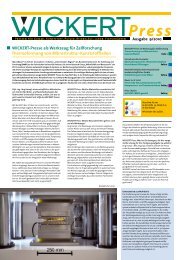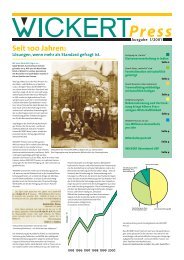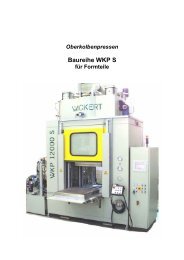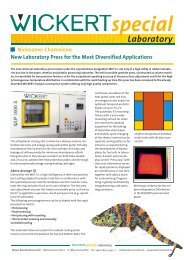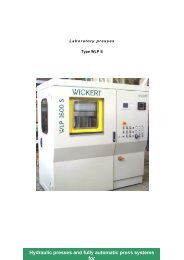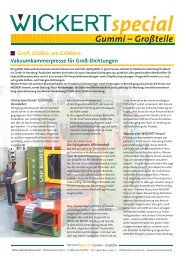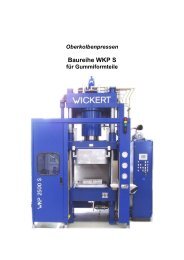WICKERT Special Thermoset-Material
WICKERT Special Thermoset-Material
WICKERT Special Thermoset-Material
Create successful ePaper yourself
Turn your PDF publications into a flip-book with our unique Google optimized e-Paper software.
Different Processes Compared:<br />
Robot-assisted Dosing and Predrying Increase<br />
the Efficiency of Press Plants<br />
special<br />
<strong>Thermoset</strong>-<strong>Material</strong><br />
The production programme of Schwab in Reutlingen covers among others also toilet seats. This plastics processor ordered for this purpose<br />
since 1998 five manufacturing plants for the processing of moulding masses of urea resin. Stipulated in the agreement for the<br />
supply of these plants was that initially only one was to install. During an optimizing phase the machine and the production process<br />
was to be utilized for the design of the remaining plants achieving thus the ultimate efficiency.<br />
The demands made on the press manufacturer<br />
in regard to efficiency and quality<br />
of the finished product were most<br />
exacting and the constructive method<br />
proved to be an unmitigated success. The<br />
four plants incorporating the experiences<br />
won produce now more than the five<br />
plants originally planned for. The plants<br />
as result of these endeavours offer a higher<br />
productivity, lower piece costs and<br />
essential improved product characteristics.<br />
This investing strategy: Entrusting<br />
the construction of the plants to people<br />
who are not only experts in their field<br />
but also solve problems innovatively and<br />
creatively certainly paid for itself. Innovated<br />
was thus a machine providing for the<br />
best possible process.<br />
The Initial Press<br />
Concept<br />
After a throughout market<br />
analysis and based<br />
on extensive experiences<br />
with the presses already<br />
in use the company<br />
at home in Reutlingen<br />
awarded <strong>WICKERT</strong><br />
Maschinenbau with a<br />
contract for development<br />
and design. Installed by<br />
Schwab GmbH was a<br />
press of the Type Series<br />
WPA 5500 with volumetric<br />
roller dosing and<br />
hopper preheating. In<br />
this model the moulding<br />
material was distributed in lumps, all of<br />
the dosing parameters were manually<br />
adjusted. A downtime of four hours was<br />
necessary after a change of mould. Such<br />
changes took place three times weekly<br />
during three shift operation on 250 week<br />
days involving thus 600 unproductive<br />
cleaning hours. An optimization was thus<br />
regarded as dire necessity. The second<br />
important aspect was an investigation<br />
into an improvement of the cycle time.<br />
Alternative Press Concept for Multiple<br />
Advantages<br />
The operators, technicians and engineers<br />
participating in the development and<br />
testing of the pilot press focused their<br />
efforts foremost at the potential in optimating<br />
of cycle time and cleaning dura-<br />
special: <strong>Thermoset</strong>-<strong>Material</strong><br />
tion. This was to be accomplished prior<br />
to delivery and installation of the four<br />
subsequent machines. The easy way for<br />
the <strong>WICKERT</strong> team would have been to<br />
resort to its experiences by simply improve<br />
the existing design. Another procedure<br />
as adapted:<br />
The initial machine was redesigned and<br />
a completely new production process<br />
realized. Three further plants should prove<br />
to be adequate to reach the desired<br />
production capacity. End of May 1999<br />
<strong>WICKERT</strong> suggested a solution, which<br />
originally increased the investment by 30<br />
% in comparison to the initially supplied<br />
version. What was the idea behind it?<br />
The roller dosing was to be replaced by a<br />
gravimetric one and the mould material<br />
distribution conceived as continuouslypath<br />
controlled. By this system the moulding<br />
material could be better adapted to<br />
the product geometry and shorter flow<br />
paths were achieved. Warranted by this<br />
method was an improved reproducibility<br />
and mould material distribution.<br />
Reproducibility without<br />
Compromises<br />
All of the parameter were manually<br />
selected for the roller dosing machine.<br />
This bears the risk of operating errors.<br />
This task is in the new machine concept<br />
in the responsibility of the SPS control.<br />
The batch-dictated parameters can now<br />
be the plant called up preselected with<br />
the SPS.<br />
The new version differs also by the defi-<br />
Wickert Maschinenbau GmbH · Wollmesheimer Höhe 2 · D-76829 Landau/Pfalz · Tel. ++49 (0) 63 41 -93 43 - 0 · info@wickert-presstech.de · www.wickert-presstech.de
ned drying of the granulate with the<br />
Duroline dryer which replaces the former<br />
hopper predrying.<br />
Predrying with Many Merits<br />
The processed urea resin moulding<br />
material is during the processing with<br />
predrying less exposed to postshrinkage.<br />
Improved is also the impact resistance,<br />
further more density and hardness,<br />
which positively influence the application<br />
scope. Even the flexibility is essentially<br />
improved. Predrying shows even at a first<br />
glance a visibly better surface gloss.<br />
Less Tool and Plant Wear, Savings<br />
in <strong>Material</strong>, Energy and Production<br />
Time<br />
The predrying of the granulate as part of<br />
the drying process allows for a reduced<br />
pressure. Press and tool being thus subject<br />
to considerably reduced wear and<br />
tear.<br />
The improved material properties and<br />
thinner wall thickness due to predrying<br />
will save not only on energy and time<br />
but equally on material consumption,<br />
with urea resins the predrying allows for<br />
curing times reduced by about 25 to 35 %.<br />
Advantages also for the Environment<br />
The new methods enable contrary to<br />
other predrying systems extensive automation.<br />
The generation of dust is for<br />
the benefit of the environment and the<br />
products greatly reduced. Reduced is also<br />
the emission of formaldehyde. With a<br />
precise adjustment of the granulate residual<br />
moisture rejection of parts caused<br />
by distortion are excluded the same way<br />
as shrink phenomenon’s. This bears great<br />
merit as to the consumption or recourses.<br />
Calculations of Economics are Convincing<br />
<strong>WICKERT</strong> produced an unambiguous<br />
comparison of plants with roller dosing<br />
and hopper predrying and plants with<br />
robot-dosing and Duroline predrying.<br />
The extra costs of 31 % per press are more<br />
than compensated by the capacity increased<br />
by 45 %. Of consequence are also<br />
special: <strong>Thermoset</strong>-<strong>Material</strong><br />
the described product and process advantages.<br />
Finally could with the realization<br />
of the new concept the number of plants<br />
be reduced from five to four. Decision is<br />
further facilitated by: The initial plants<br />
without Duroline predrying and robotdosing<br />
could at a reasonable price be<br />
converted by Wickert to the sophisticated<br />
version here described. In conclusion this<br />
proves that at about equal investment<br />
volume the four presses now installed<br />
offer ample capacity reserves and at<br />
the same time the technically superior<br />
production of essentially improved endproducts.<br />
Wickert Maschinenbau GmbH · Wollmesheimer Höhe 2 · D-76829 Landau/Pfalz · Tel. ++49 (0) 63 41 -93 43 - 0 · info@wickert-presstech.de · www.wickert-presstech.de
Pressing of <strong>Thermoset</strong>-materials to a New Standard<br />
Cycle Times reduced by up to 30 % Improve Product Properties<br />
But a few years ago it was predicted that<br />
thermoplast will entirely replace durable<br />
plastic materials for their more efficient<br />
processing methods employed. Investments<br />
in production plants for thermoset-materials<br />
ceased thus also almost<br />
completely. Thermoplast can, however,<br />
not replace thermoset-material in all<br />
applications, in fact experts speak of a<br />
come back of the latter material.<br />
The contemporary problem: The machines<br />
in use are generally outdated and<br />
deficient in efficiency and productivity so<br />
that the machining of thermoset-materials<br />
lacks economy and cannot compete<br />
on this special market. Enormous improvement<br />
potentials apply especially to two<br />
process stages, potentials to be exploited<br />
if competitiveness is to be restored; that<br />
is dosing and drying.<br />
Automatic Dosing<br />
<strong>Material</strong> suitable for pouring can, for<br />
instance, be gravimetric or volumetric<br />
dosed and be passed into a hopper with<br />
fully automatic closing flaps. The hopper<br />
is then passed into the open mould,<br />
opens the closure and carries the dosing<br />
out. The material mass can thus be per-<br />
fectly dosed and matched<br />
to the manufacturing conditions.<br />
An improved distribution<br />
of the mould material<br />
bears finally down in a<br />
better product. A further<br />
advantage being presented<br />
by the change of<br />
moulds and material. It is<br />
quite feasible to automate<br />
process steps as partial<br />
evacuation and blowing<br />
out of the mould.<br />
Drying Reduces Cycle<br />
Times by up to 30 %<br />
This has been convincingly<br />
demonstrated with urea<br />
resin mould material where<br />
by intelligent preheating<br />
respectively defined<br />
material drying at a dew<br />
point of –50°C this time<br />
saving can be actually<br />
attained. The new Duroline<br />
presses preheat the mould material<br />
to a reproducible dry state in conjunction<br />
with an exact material dosing and<br />
an additional dedusting – and allow<br />
thus for reproducible product properties.<br />
An efficiency not possible achieved<br />
with the conventional presses. It<br />
is hardly surprising that these presses<br />
attracted the attention of the market.<br />
Their operation not only results in a<br />
higher productivity but also provides<br />
for an essentially better mould quality<br />
special: <strong>Thermoset</strong>-<strong>Material</strong><br />
through a controlled molecular surface<br />
moisture.<br />
The Duroline presses and the sophisticated<br />
Siemens S7 control allows a problemless<br />
operation.<br />
The Duroline presses are outstanding for<br />
the accessibility from four sides for all<br />
handling activities or the maintenance<br />
and cleaning chores. The design of the<br />
closing unit in down-stroke four-column<br />
design makes this possible.<br />
Wickert Maschinenbau GmbH · Wollmesheimer Höhe 2 · D-76829 Landau/Pfalz · Tel. ++49 (0) 63 41 -93 43 - 0 · info@wickert-presstech.de · www.wickert-presstech.de
Injection Moulding with Recycled Plastics<br />
The ever increasing consumption of plastics calls urgently for a sensible recycling of waste. Foil wastes e.g. of agricultural and industrial<br />
activities and waste, collected by communal enterprises, are processed to regranulates or agglomerates, which provide difficulties for<br />
conventional injection moulding machines.<br />
The injection moulding machine of the Type WPM, first introduced<br />
at the FAKUMA 97, closes this gap. A special for recycling<br />
plastic developed injection moulding unit and a unique ratio between<br />
clamping force, mounting surface and shot volume (3.8 to<br />
23 l) are basic characteristics of this machine.<br />
An uncomplicated and efficient utilization of plastics waste<br />
has been given top priority by the recycling and waste disposal<br />
legislation. A target which can be effectively approached with<br />
the injection moulding machines of the Type WPM, machine<br />
conceived for this purpose. By this method plastics waste disposal<br />
by incineration called “thermal disposal” can be avoided. The<br />
machines can also cope with badly contaminated, unclassified<br />
and unsorted material and convert it into high grade technical<br />
mouldings.<br />
The conversion of plastics waste into moulded technical articles<br />
represents undoubtedly a sensible environmental protective<br />
utilization of waste which is thus possibly two to three times<br />
reconverted into base material. This is not only strived for from<br />
an ecological but also from an economical aspect as the recycled<br />
material or regranulate offers decisive monetary advantages for<br />
processors. WPM machines are a future-orientated investment<br />
for waste disposal and processing enterprises.<br />
The injection unit with screw preplasticing in combination with<br />
an injection plunger is highly wear resistant and will cope effectively<br />
with material greatly differing in composition, structure<br />
and staining.<br />
The machine commands of a servo-assisted plastification acting<br />
as adjustable friction force compensation in the injection cylinder.<br />
The plastification pressure in the cylinder can thus be matched<br />
to the conditions of the production process. The conventional<br />
injection units were exposed to risks in the processing of<br />
recycled material. The machine suffered frequently early dama-<br />
Locking bolts<br />
ges or even destruction by the abrasive aggregates, blocking<br />
often resulted in breakdowns. Contaminates such as metal, glass,<br />
paper, stones, fibres, aluminium residues and copper fragments<br />
are highly abrasive and produce material blockages.<br />
By combination of screw plastification and plunger injection<br />
operation can be conducted with large cross sections, which give<br />
access even to large foreign bodies. Equipment of these machines<br />
includes neither check valves nor retainer rings. Operation is carried<br />
out with locking bolts being hydraulically operated and cannot<br />
be inactivated even by such foreign bodies as steel screws or<br />
copper wire. The rugged machines offer thus a virtually troublefree<br />
operation despite being charged with problematic material.<br />
The also new design of the screw geometry enables a complete<br />
plastification at the possibly lowest temperature. The generation<br />
of gases and corrosive material being such extensively avoided.<br />
The highly wear resistant injection unit tolerates such stabilizers<br />
e.g. wood shaving, rubber meal and glass fibres.<br />
Injection moulding of large volume parts<br />
Recycled material and agglomerates from communal waste<br />
disposal, TETRA-PAK fraction<br />
Thermoplasts e.g. filled with wood shavings<br />
special: <strong>Thermoset</strong>-<strong>Material</strong><br />
Screw plastification<br />
Plunger (ram) injection<br />
Wickert Maschinenbau GmbH · Wollmesheimer Höhe 2 · D-76829 Landau/Pfalz · Tel. ++49 (0) 63 41 -93 43 - 0 · info@wickert-presstech.de · www.wickert-presstech.de
For Moulded <strong>Thermoset</strong>-material Parts:<br />
New Standard Presses and Automatic Machines for Top Productivity<br />
Wickert offers now machines with absolutely unique features for the manufacturing of moulded <strong>Thermoset</strong>-material parts. These<br />
machines provide for reduced cycle times and improved surface finish due to an intelligent press technique with effective predrying:<br />
Wickert has thus supplemented their programme in machines for the production of Elastoform parts with plants for the processing of<br />
<strong>Thermoset</strong>-material – offering sophisticated and extreme economical solutions.<br />
Used for the manufacturing of moulded<br />
<strong>Thermoset</strong>-material parts are hydraulic<br />
presses with which the required retention<br />
force can be applied. The mould material<br />
is in the machine heated with heat plates<br />
or by direct tool heating and attains thus<br />
the desired material properties. Up to this<br />
stage procedures for <strong>Thermoset</strong>-material<br />
and Elastomer parts do not essentially<br />
differ.<br />
The production of rubber mould parts<br />
offer great difficulties to automation<br />
while this represents the state of art<br />
where parts of <strong>Thermoset</strong>-material are<br />
concerned. The pourable initial material is<br />
for this purpose volumetrically predosed<br />
and then automatically fed into the cavities.<br />
In case of tools with multiple cavities<br />
or with large surfaces several lumps are<br />
predosed to achieve a better material<br />
distribution in the tool. The procedure is<br />
confronted with a number or problems<br />
e.g. cleaning of the plant is complex and<br />
time consuming i.e. changing of material<br />
of mould is difficult and frequently avoided.<br />
Yet multi-coloured are frequently<br />
specified for sanitary articles – which is<br />
by <strong>Thermoset</strong>-material processors correctly<br />
termed as disadvantage of this<br />
production method.<br />
Especially in the tools with large surfaces<br />
the “predosing in several lumps” does not<br />
effect an optimum distribution of the<br />
material into the cavities.<br />
A further problem being presented in<br />
the hygroscopic characteristics of the<br />
moulding material. It is for one due to<br />
the surface moisture (hygroscopic effect)<br />
and secondly to the bonded molecular<br />
moisture. The molecular moisture is used<br />
for the process and thus desired, surface<br />
moisture interferes with the processing.<br />
If the surface moisture can be reduced to<br />
a defined value prior to processing not<br />
special: <strong>Thermoset</strong>-<strong>Material</strong><br />
only a higher quality is achieved for the<br />
product but also a cycle time reduced by<br />
up to 30 %.<br />
Besides many intelligent detail improvements<br />
the Wickert-Duroline above<br />
all provides for the <strong>Thermoset</strong>-material<br />
processors advantages as to dosing and<br />
material drying.<br />
A real novelty is presented with the<br />
newly developed Duroline dryer; the<br />
mould material is thus prior to processing<br />
reproducible predried. Next to the already<br />
mentioned briefer cycle time of up to 30<br />
% also an improvement of the physical<br />
properties, is achieved.<br />
Shorter cycle time and improved<br />
surface finish<br />
Intelligent press technique<br />
Effective preheating<br />
Wickert Maschinenbau GmbH · Wollmesheimer Höhe 2 · D-76829 Landau/Pfalz · Tel. ++49 (0) 63 41 -93 43 - 0 · info@wickert-presstech.de · www.wickert-presstech.de



